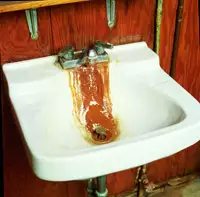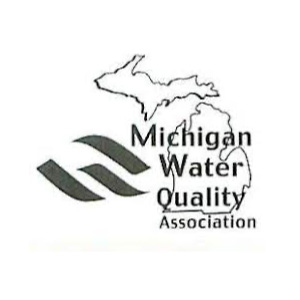Problems and Solutions
Have you ever tasted metal in your water? Or noticed reddish-brown stains on your sinks, toilets, or laundry? These are typical indicators of excessive iron in your water supply. Iron, a naturally occurring element in the earth’s crust, can infiltrate your water, affecting its taste and appearance and potentially causing long-term damage to your plumbing system.
Iron-contaminated water is a common issue, particularly for households relying on well water. Understanding the sources of iron contamination, its effects on water quality, and available solutions is crucial for maintaining safe, clean water in your home. This guide will explore the causes of iron in water, its impact on water quality, and how to address this issue effectively.
Why Iron Gets into Water
Iron infiltration in water supplies is a complex issue with multiple potential sources. Understanding these sources is crucial for homeowners to identify the root cause of their iron problems and choose the most effective treatment solution. Various scenarios lead to iron contamination, and it’s important to be aware of them. Let’s explore the main culprits behind iron in your water.
Iron can enter your water supply through various means:
- Natural Sources: As water percolates through soil and rock formations rich in iron, it can dissolve and carry iron particles into groundwater reservoirs. According to the Illinois Department of Health, “Rainwater as it infiltrates the soil and underlying geologic formations dissolves iron, causing it to seep into aquifers that serve as sources of groundwater for wells. Although present in drinking water, iron is seldom found at concentrations greater than 10 milligrams per liter (mg/L) or 10 parts per million.”
- Corroded Plumbing: Water flowing through corroded iron pipes can pick up additional iron content in older homes.
- Industrial Contamination: Nearby industrial activities or mining operations can sometimes contribute to elevated iron levels in local water supplies.
- Environmental Factors: Fluctuations in groundwater levels due to heavy rainfall or drought can affect iron concentration in water sources.
These sources can introduce different forms of iron into your water, each requiring specific treatment approaches. A comprehensive water testing process allows experts to pinpoint the exact nature of your iron problem, which allows them to recommend the most effective treatment solution. Remember, the key to solving iron issues is first understanding their origin.
How Iron Affects Your Water
Iron contamination in water can have far-reaching effects on your daily life, impacting everything from your morning coffee to your household appliances. It’s not just about aesthetics – iron can lead to expensive repairs and replacements if left untreated. Understanding these impacts can help you recognize the importance of addressing iron issues promptly. Let’s delve into the specific ways iron can affect your water and home:
- Taste and Odor Issues: High iron content often results in a metallic taste and sometimes a rusty odor in water. According to the Vermont Department of Health, “Consuming water containing iron is not harmful to your health. High levels of iron may cause:
- A metallic taste
- A bad smell
- Rusty-colored water
- Mineral deposits on toilets, sinks and bathtubs
- Sedimentation (for example, small particles of iron settling at the bottom of a water glass)
- Reddish or orange staining on laundry or surfaces that come in contact with the water
None of these effects poses a health risk.”
- Discoloration: Iron can cause water to appear red, yellow, or brown, making it unappealing for consumption and use.
- Staining: Iron-rich water frequently leaves reddish-brown stains on laundry, plumbing fixtures, and dishware.
- Plumbing Problems: Over time, iron buildup can clog pipes, reduce water pressure, and damage water-using appliances.
- Iron Bacteria Growth: Some types of bacteria thrive in iron-rich environments, forming slimy deposits in plumbing systems.
The impacts of iron contamination extend beyond these immediate issues. Over time, iron can lead to significant plumbing problems, potentially requiring extensive and costly repairs. It can also shorten the lifespan of water-using appliances like washing machines and dishwashers. Addressing iron issues promptly is crucial to prevent these long-term consequences and maintain the quality of your water and the integrity of your home’s plumbing system.
Solutions for Iron in Water
When tackling iron in your water, there’s no one-size-fits-all solution. The most effective treatment depends on factors like iron type and concentration, water source, and the household’s specific needs. Modern water treatment technology offers a range of options to address various iron contamination scenarios. The goal is to find a tailored solution that not only removes iron but also improves your overall water quality. Here are some of the advanced treatment options available:
- Advanced Water Softeners: Cutting-edge water softeners can effectively remove dissolved iron along with water hardness minerals.
- Oxidation Filtration Systems: Specialized oxidation systems provide comprehensive iron removal for higher iron concentrations or when dealing with both dissolved and particulate iron. According to the Minnesota Department of Health, “Iron filters (such as a manganese greensand filter) are a common treatment for red-water iron levels up to 10-15 mg/L.”
- Reverse Osmosis Systems: Point-of-use reverse osmosis systems deliver high-quality, iron-free drinking water directly at your tap.
Each solution has strengths, and the best choice depends on your situation. Water treatment specialists can analyze your water test results and recommend the most appropriate system for your home. Effective iron removal is not just about installing a system—it’s about finding a comprehensive water treatment solution. Regular maintenance and follow-up testing are crucial to ensure your chosen system continues to perform optimally over time.
What to Do If You Have Iron in Your Water
Discovering iron in your water can be concerning, but with the right approach, it’s a problem that can be effectively solved. There’s a straightforward process that can help homeowners address their iron issues quickly and efficiently. The journey from iron-contaminated water to clean, clear water can be smooth with the right guidance. Here’s what experts recommend if you suspect iron contamination in your water:
- Test Your Water: Contact a reputable water treatment company for a professional water analysis to test for iron levels and types of iron.
- Expert Consultation: Have water treatment specialists review your test results and assess your needs.
- Customized Solution: Based on the consultation, your water treatment company will give you a recommendation for the most appropriate treatment system for your situation.
- Installation and Ongoing Support: Once you’ve chosen a system, ensure it’s properly installed. Look for providers that offer regular maintenance services and follow-up testing to ensure your system continues to perform optimally.
Remember, addressing iron contamination is not just about improving water quality today – it’s about protecting your home and ensuring clean water for years to come. The focus should be on finding a long-term solution, not quick fixes. Working with experienced professionals every step of the way, from initial testing to system installation and beyond, can ensure you always have an expert to turn to for your water treatment needs.
Kohley’s Superior Water: Your Iron Removal Experts
At Kohley’s Superior Water, we’re committed to solving your water quality issues, as we have been since we opened our business in the 1960s. Our team of trained and experienced professionals understands the challenges posed by iron contamination and offers tailored solutions to ensure your home enjoys clean, clear, and great-tasting water.
We take pride in our range of advanced water treatment technologies designed to effectively address iron and other water quality concerns. “Our solutions not only improve your water quality but also protect your plumbing and appliances, potentially saving you money on repairs and replacements in the long run,” says Manager Paul Johnson, who has been with the company for 32+ years.
Don’t let iron compromise your water quality any longer. Reach out to Kohley’s Superior Water today to schedule your free water analysis and discover how we can transform your water. Our dedicated team is ready to help you achieve the superior water quality you deserve. Contact us at (800) 686-3224 or fill out our online form to request your complimentary water analysis and take the first step towards iron-free water in your home.




